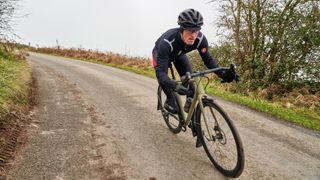How to avoid wrist pain when cycling
Physiotherapist Nicole Oh brings the lowdown on avoiding - and treating - the dreaded 'Handlebar Palsy'

Do you find that you are constantly moving your hands around the handlebars and giving them a shake? Hand and wrist pain is a common discomfort experienced when cycling, particularly on longer rides.
Wrist pain in road cyclists usually stems from contact at the handlebar and compression of the ulnar nerve, which originates from your neck and runs right through to your hand.
Ulnar Nerve Palsy is often called Cyclist's Palsy or Handlebar Palsy, which illustrates quite how common it is as an injury among bike riders. In some instances, the nerve can become temporarily damaged, causing pain off the bike. In most cases, the damage can be repaired by rest, and addressing the cause.
This issue is most common among riders undertaking long distance cycling, multi-day events, and ultra-endurance events. With prevention always preferable to cure, it’s worth addressing your bike fit and equipment choices before setting off on long, multi-day adventures.
What causes Ulnar Nerve Palsy?
Case study - Professional Bassoonist
A professional Bassoonist came to see me in clinic with hand weakness following cycling, which had been occurring for a month. She had very little pain and no numbness or tingling whilst riding, but noticed that after a ride, she had a loss of dexterity and weakness in her 5th finger, which would persist for a couple of days. She had difficulty bending or abducting (moving out) her 5th finger, both actions essential to play the bassoon!
She had her bike fitted at a bike shop previously, where they moved the saddle forwards to decrease the reach. This had the effect of overloading her hands, with too much weight now towards the front of the bike, compressing the ulnar nerve at her wrist. She was also experiencing some saddle discomfort, and had a very toe down pedal stroke, mainly because the saddle had been set too high.
To off-load her hands, I moved the saddle down and back, and decreased the downward tilt of the saddle. I did not need to change the length of the stem, but instead moved the hoods closer and rolled the bars down to decrease the reach. I also moved her cleats back, which along with lowering the saddle, increased her foot stability, further off-loading her hands. She didn't need any particular exercises in this case (besides the Hand Therapy she was already receiving), the changes to her bike set up were enough to do the trick!
Compression of the ulnar nerve occurs as it passes through what is known as ‘Guyon’s canal’, a tight tunnel formed between the bones on the outside/5th finger side of the wrist. When the wrist is held in a hyperextended position, as when riding a bicycle, the nerve may be both stretched and compressed simultaneously. The results will usually be felt as pain at the point of compression - usually the wrist - alongside pain, numbness and tingling in the hand and fingers. In extreme cases, you may experience weakness, cramping or loss of dexterity, and the problem can be exacerbated by vibration from the road, particularly on rough surfaces.
Like many cycling injuries, a poor bike fit can be a major contributing factor to increasing the weight on your hands, or putting your wrists in a hyperextended position where there is more tension on the ulnar nerve.
An excessive drop created by an aggressive position, a saddle that’s tilted down too much, or the centre of gravity being set too far forward (eg. if the saddle is pushed forward) will all place more weight on the hands and wrists. Handlebars that are too wide may cause the rider to bend the wrists back (hyperextend) to try to achieve a narrower shoulder position, and a reach that is too long will also put more tension/traction on the ulnar nerve. Handlebars that are rolled up to angle the hoods up (often used to decrease reach and drop) causes you to hyperextend your wrist to reach the levers when riding in the drops. Furthermore, riding in the drops for long periods of time can exacerbate wrist pain due to the prolonged extension of the wrist in this position.
Get The Leadout Newsletter
The latest race content, interviews, features, reviews and expert buying guides, direct to your inbox!
How to prevent Ulnar Nerve Palsy

If you’ve identified Ulnar Nerve Palsy as your problem, you’re probably wondering what you can do about it. First and foremost, you need to reduce compression or vibration at the point where your wrists contact the handlebars.
Cushioned bar tape and gel padding via a quality pair of cycling gloves or mitts are your first port of call. Look for thicker bar tape, and gloves with padding specifically designed to protect the ulnar nerve.
Changing hand position regularly during a long ride from the hoods to tops to drops will also help decrease load, many ultra distance cyclists opt to fit aerobars to distribute load to the forearms. You should also try to relax your elbows and shoulders and try not to overgrip, which is made easier with a good bike fit!
Riding wider tyres with lower pressures can also dampen the harshness of the road and reduce vibration through your wrists and hands.
Finally, a good bike fit is necessary to ensure that your set up places you in a position which is both comfortable and sustainable for the duration of your typical ride, avoiding excessive weight being placed upon your hands. Your handlebar width should mirror that of your shoulders, allowing you to adopt a neutral position.
Often we come to a dilemma when it comes to balancing weight on the front of the bike versus too much reach. Moving the saddle and your centre of gravity back will put less weight on your hands, but it may also then result in excessive reach. If the stem and handlebars cannot be shortened any further, it may be hard to get you in a good position on that bike.
Your posture on the bike - the position of your spine, shoulders, elbows and wrists - will influence how much load is going through the hands, if tight points and weaknesses are contributing to the problem, working on flexibility, core strength and endurance may help to minimise fatigue and extra loading of the hands.
Adjusting reach and drop
Both excessive reach and excessive drop can contribute to compression of the ulnar nerve via increased weight on the handlebars and putting more traction on the nerve. This is also a common bike fit issue in cycling-related neck pain.
The most common way to decrease the reach is to fit a shorter stem, although an excessively short stem can make the steering twitchy. You can also decrease the reach by fitting bars with a short reach, so bars with a reach closer to 70mm than 100mm, as well as ensuring they are the correct width for your shoulders. Having the hoods placed high on the handlebars will also decrease the reach; however, you may need to roll the bars down to ensure you can still access the levers in the drops.
Increasing the height of the handlebars may be more difficult, particularly if you have purchased a bike that is not the correct size or geometry for you, or the steerer has already been cut (in order to slam the stem). If there are spacers on top of the stem, the height can be easily increased by moving those spacers to below the stem. If all the spacers are already underneath the stem, the only option to raise the handlebars is to invert the stem to a positive rise, which may not be possible with all bikes and can also affect the handling.
Physiotherapy management for more severe ulnar nerve injury

Ulnar Nerve Palsy is usually reversible, although the source of the compression needs to be removed for healing to occur. These are never words a cyclist likes to hear, but a period of time off the bike may be required. The nerve will regenerate and muscle function will be restored, this could take weeks or months - but it’s worth being patient here, returning to cycling too soon could ultimately result in a longer rest period.
Initially, ice/heat and anti-inflammatories can be used to control swelling and pain. Specific exercises recommended by a physiotherapist to strengthen the hand muscles affected will aid recovery, and nerve mobility exercises may also be required. A physiotherapist will also check the neck, upper back and elbow for issues which may be contributing, and treat these if required. Finally, splinting may be used in some cases to prevent contractures and facilitate muscle activity.
Summary: how cyclists can treat and prevent wrist pain
Wrist pain and numbness or tingling in the hands is a common discomfort experienced by road cyclists, due to compression of the ulnar nerve at the base of the wrist. It is usually caused by excessive weight being taken through the hands and wrists, or the wrist being held in a hyperextended position which puts increased traction on the nerve as it is being compressed. An appropriate bike fit should help to alleviate these issues, as well as optimising equipment such selecting padded bar tape, padded gloves and wider tyres. A strong core and good flexibility will help you hold your trunk comfortably in the forward lean cycling position rather than leaning on your hands.

Thank you for reading 20 articles this month* Join now for unlimited access
Enjoy your first month for just £1 / $1 / €1
*Read 5 free articles per month without a subscription

Join now for unlimited access
Try first month for just £1 / $1 / €1
Nicole Oh is a physiotherapist and bike fitter, with training in biomechanical assessments, sports injury rehabilitation, acupuncture and clinical pilates.
A competitive cyclist with a background in triathlon, Nicole raced at National level in the UK, also managing and co-founding the Les Filles Racing Team. Having moved to Sydney, she works as a physiotherapist at The Body Mechanic and continues to race competitively.
-
 'I'd love to be an F1 driver': Get to know GB track sprinter Emma Finucane
'I'd love to be an F1 driver': Get to know GB track sprinter Emma FinucaneWorld sprint champion tells Cycling Weekly about her earliest Olympics memories, drinking coffee in Jakarta, and her passion for F1
By Tom Davidson Published
-
 'I felt like I was the worst rider in the bunch' - Simon Carr dispels doubt with longest ever solo win at Tour of the Alps
'I felt like I was the worst rider in the bunch' - Simon Carr dispels doubt with longest ever solo win at Tour of the AlpsBrit triumphs from lone 45km breakaway, after days of battling allergies
By Tom Davidson Published